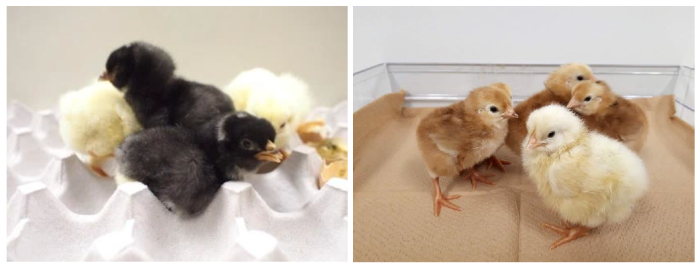This exciting, virtual event brings together university, industry, venture investment, non-profit and government experts to review, discuss and advance innovations.
Tag: Food Safety
The Detection of a Massive Harmful Algal Bloom in the Arctic Prompts Real-Time Advisories to Western Alaskan Communities
In summer of 2022, a research cruise detected a massive harmful algal bloom (HAB) in the Bering Strait region of western Alaska. This expedition provided a dramatic example of science utilizing new technology to track a neurotoxic HAB, and effectively communicate information that protects remote coastal communities in real-time.
Beef freshness unveiled: innovative pH indicators monitor meat quality in real-time
In a bid to combat food waste and enhance safety, researchers have introduced a pioneering method for gauging the freshness of raw beef using on-pack pH indicators. This new system provides consumers with a direct visual cue of meat quality, effectively navigating beyond the limitations of traditional best-before labels.

Fourth of July story ideas: Fireworks safety, economics and hot dog competitions, food safety and more
Ahead of Independence Day on July 4, Virginia Tech experts can speak on a variety of topics, including fireworks safety, economic lessons from eating contests, grilling safety tips, and more. To schedule an interview, please contact the media relations office at [email protected]. Fireworks safety The July 4th holiday brings a dramatic increase in eye injuries each year.
FDA Warns of Contaminated Oysters and Clams
The Food and Drug Administration says shellfish from a number of states could be contaminated with toxins that cause paralytic shellfish poisoning. Paralytic shellfish poisoning is caused by eating shellfish contaminated with saxitoxin which causes gastrointestinal distress. According to the…
Camelid nanobodies: transforming food allergen analysis
Recent advancements show nanobodies from camelid antibodies excel in food allergen detection with superior stability, specificity, and cost-effectiveness. This innovative approach aims to improve accuracy and efficiency, crucial for preventing severe allergic reactions.
Food Safety and Quality Review Summarizes Sustainable Seafood Preservation Techniques to Minimize Wastes and Losses
Seafood is widely savored worldwide and a staple in many regions. However, the seafood processing industry struggles with significant waste generation, causing financial and socioecological issues. A Food Safety and Quality review describes emerging chemical and physical preservation techniques that can overcome the challenges associated with conventional preservation approaches. The review highlights innovative techniques which can significantly improve the shelf life of seafood and retain their sensory attributes, in an efficient, sustainable and cost-effective manner.

Expert shares tips for food safety at cookouts and potlucks
As the summer season approaches, lots of people will be planning to host or attend backyard cookouts and potlucks. But before you fire up the grill, Virginia Tech food safety expert Melissa Wright shares tips to protect yourself, your family, and your friends from foodborne illnesses during the warm-weather months. “Safe food handling when eating outdoors is critical,” says Wright.
Register for Food and Nutrition Institute’s Fourth Annual Conference on Science, Regulation
Event at National Press Club features nutrition, food safety scientists and leaders addressing major issues with a research and regulatory lens.
Grocery Store Milk Tested Positive for Bird Flu
Barbara Kowalcyk, associate professor of exercise and nutrition sciences at the George Washington University Milken Institute School of Public Health is available to provide information on blu flu and the risk to food safety. Janet Buffer, food safety expert at…
Register Today for Food and Nutrition Institute’s Fourth Annual Conference on Science, Regulation
Registration is open for what promises to be an exciting scientific program with important technical updates for those curious about science in the food and beverage sector.
Revolutionizing Infant Formula Safety: A New Frontier in Pathogen Detection
Cronobacter sakazakii is a harmful germ that can be found in powdered baby formula. It can cause very serious health problems in infants, such as meningitis and septicemia. Right now, it takes a long time and is complicated to check if the germ is in the formula. However, a new study has created a special test that uses a computer program to find the germ in the formula. This new method makes it easier and faster to find the germ, which is known for causing serious illness in babies. It helps make sure that baby formula is safe to use.
By growing animal cells in rice grains, scientists dish up hybrid food
From lab-grown chicken to cricket-derived protein, these innovative alternatives offer hope for a planet struggling with the environmental and ethical impacts of industrial agriculture.
The Institute for the Advancement of Food & Nutrition Sciences is Now Accepting Applications for Summer Research Opportunity Fellowships
Part-time, summer opportunity for graduate students to directly participate in advancing food safety or nutritional sciences.
Ultra-processed foods score worse on food package labelling
Ultra-processed foods (UPFs) contain more calories, fat, saturated fat, sugar and salt than minimally-processed foods – but not all UPFs are unhealthy, according to new research from UCL.
IAFNS Looks Ahead at Third Anniversary to More Actionable Science, Data-Sharing
IAFNS enters its fourth year as a science-focused nonprofit uniquely positioned to mobilize government, industry and academia to drive, fund and lead actionable research.

Paper: Multistate foodborne illness outbreaks impact restaurant stock price, public perception
As demand for food from restaurants soars in the U.S., so does the importance in understanding the impacts of foodborne illness outbreaks. A new paper co-written by a University of Illinois Urbana-Champaign expert in food marketing and food policy finds that outbreaks spanning multiple states bring swift financial losses, increased media attention and a public-relations hit that makes smaller outbreaks more financially damaging.
Pathogen that plagues food processing plants eradicated by blue light
Blue light kills both dried cells and biofilms of the pathogen Listeria monocytogenes, a frequent contaminant of food processing facilities.
Researchers create packaging tray that warns of contamination before food is unwrapped
Researchers at McMaster University have created a new packaging tray that can signal when Salmonella or other dangerous pathogens are present in packages of raw or cooked food such as chicken.
Expert offers safety tips for grilling beef-alternative burgers on Memorial Day
Hamburgers are an American classic. There are few foods that embody what a Memorial Day weekend should taste like sinking your teeth into a juicy burger hot off the grill. But with more and more Americans opting for beef-alternatives like plant-based and turkey burgers in recent years, it’s important to keep in mind that the requirements for safely cooking and enjoying a beef hamburger won’t necessarily apply to a black bean burger.
Overcoming nuke stigma through critical thinking
The food contamination that followed the Fukushima nuclear plant incident in 2011 caused widespread fear, both within Japan and internationally.
New technique for detecting foodborne illness early
University of Delaware researchers have developed a new technique to catch bacteria in the act, detecting it on produce before it reaches stores, restaurants and consumers’ plates. The new platform can detect foodborne pathogens in three to six hours.

Confirming the safety of genetically edited allergen-free eggs
Researchers have developed a chicken egg that may be safe for people with egg white allergies.
Join Us As IAFNS Convenes Food Science, Regulatory Experts at National Press Club June 13-14
Annual conference speakers to address cutting-edge nutrition and food safety topics.
Registration Opens for Food and Nutrition Institute’s Annual Conference on Science, Regulation
A June 13-14 gathering of scientific and regulatory experts at the National Press Club
IAFNS Looks Ahead at 2nd Anniversary with Focus on Food, Nutrition, Transparency
Advancing food science for public health benefit through transparency and collaboration.
Wearable, Printable, Shapeable Sensors Detect Pathogens and Toxins in the Environment
Researchers at Tufts University have created a biopolymer sensor that can be printed on or embedded in wide range of materials, including gloves, masks, and everyday clothing. The sensor lights up when exposed to specific pathogens, toxins, proteins, or chemicals.
Evidence Map of Gut Metabolites Identifies Links to Cancer, Digestive Disorders
Review of over 300 studies sifts out relationships between metabolites and health worth a further look.
Dec. 13-15 Science Innovation Showcase Highlights Alternative Proteins, Next-Gen Topics
Afternoons-only, virtual conference features talks on food labels, ‘safe’ ingredients and more.
A disinfectant spray that deploys “billions of tiny soldiers”
Researchers have created a powerful new weapon against bacterial contamination and infection by developing a way to spray bacteriophages – harmless viruses that eat bacteria – onto food and other materials to rid them of harmful pathogens.
Poison Control Center Tips on Preventing Illness this Holiday Season
A Rutgers New Jersey Poison Control Center expert discusses how children and adults can reduce risks of poisoning
Words matter in food freshness, safety messaging
Changing the wording about expiration dates on perishable food items – which is currently unregulated and widely variable – could help reduce food waste, according to a new Cornell University-led study.
When Tapas Can Cause Harm: Large Listeriosis Outbreak in Spain
Listeria bacteria are ubiquitous in the environment and consumption of food contaminated with Listeria monocytogenes is one of the main routes for food-borne outbreaks.
Toward a fully edible sensor showing if frozen food has previously thawed
Researchers reporting in ACS Sensors have designed a food-grade device from edible materials that lets you know if food has been thawed and refrozen . The proof-of-concept sensor provides a color readout when it’s warmed above a specific temperature, which is tunable from -58 F to 32 F.
Call for Papers – The International Halal Science and Technology Conference 2022 (IHSATEC): 15th Halal Science Industry and Business (HAISB)
The Halal Science Center, Chulalongkorn University, and Research Synergy Foundation, invites all to attend “The International Halal Science and Technology Conference 2022 (IHSATEC): 15th Halal Science Industry and Business (HAISB)” and has opened up a call for papers. The conference sessions will be on December 15-16, 2022 at Chulalongkorn University, Bangkok, Thailand.
Call for Abstracts on Alternative Proteins, Next-Generation Topics for IAFNS Dec. 13-15 Science Innovation Showcase
Register and submit an abstract today!
IAFNS Launches Project to Link Consumer-Articulated Cognitive Benefits with Valid Research Tools
Effort aimed at documenting which outcomes measured by cognitive performance tests are aligned with benefits sought by consumers.
Food Safety Organizations Team Up to Strengthen Research, Education and Protections
IAFNS and IAFP establish new memorandum of understanding to strengthen collaboration on food safety issues.
Stickers and a smartphone for easy nitrite detection on foods
Researchers reporting in ACS Applied Materials & Interfaces have developed a color-changing film that consumers can stick onto foods and easily analyze nitrite levels by snapping a picture with a smartphone.
Food safety tips for summer gatherings
Summer is a time for outdoor fun, picnics and cookouts. When preparing and serving food outdoors, food safety should be top of mind for everyone. Kimberly Baker, Ph.D., RD, LD, director of the Clemson Extension Food Systems and Safety Program…
IAFNS Research Assistant Develops Videos on Bulk Sampling Tool for Food Safety
IAFNS Research Assistant advances food safety sampling efforts with instructive videos for new bulk product sampling tool.

Low levels of high-risk salmonella evade traditional methods of detection
Poultry is responsible for more than one out of every five cases of salmonella infection in the U.S. But traditional methods of testing the chicken you grab off the grocery shelf may not be enough to detect all strains of the bacteria, according to new research from the University of Georgia.
Diverse Speakers Confirmed for Second Annual IAFNS Science Symposium
IAFNS June 21-23 Second Annual Meeting and Science Symposium still open for online registration
Consumers embrace milk carton QR codes, may cut food waste
The “use-by” and “best-by” dates printed on milk cartons and gallon jugs may soon become a thing of the past, giving way to more accurate and informative QR codes. A new Cornell University study finds that consumers will use the QR codes – to better depict how long the milk is drinkable and create substantially less agricultural and food waste.
Fermented Foods Surge Meets Patchwork of Regulation, Standards
IAFNS-supported study reviews country frameworks for fermented foods
Food Safety in Focus: Clarifying Potential Hazards on Low-Moisture Foods
IAFNS supports studies on threats posed by pathogens and viruses in low-moisture fruits and nuts.
Registration Opens for Food and Nutrition Science Institute’s Annual Conference
Leading food safety and nutrition scientists are meeting June 21-23, 2022, at the National Press Club.
Fitbits and Other Devices Measure Energy Expended Well, But Less Reliable for Tracking Energy Storage and Intake in Research
IAFNS-supported study finds that commercial devices do well in estimating energy outlays compared to gold-standard measures but less well on storage and intake.
“Model Kitchen” for Thai Monks to Stay Away from Illness
The Faculty of Allied Health Sciences, Chulalongkorn University, in collaboration with Maha Chulalongkorn Rajavidyalaya University propose the way to create a “model kitchen” and a variety of media to educate the public about nutrition and food safety of the offerings to monks and advise the public to make merit by building a hygienic kitchen for monks for their good health.
Food claiming to have ‘wild mushrooms’ rarely does
Harvesting wild mushrooms requires an expert eye, making products containing wild fungi expensive. Due to minimal food regulations, it’s nearly impossible to know what species are actually contained within. Sequencing revealed food products labeled with wild mushrooms mostly contained cultivated fungi and some mushrooms poisonous to humans.